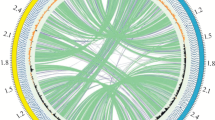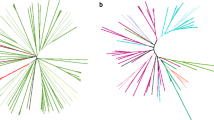Summary
A 1.6-kb fragment of DNA from the thermophilic, methane-producing, anaerobic archaebacteriumMethanobacterium thermoautotrophicum ΔH has been cloned and sequenced. This DNA complements mutations in both the purE1 and purE2 loci ofEscherichia coli. The sequence of theM. thermoautotrophicum DNA predicts that complementation inE. coli results from the synthesis of a polypeptide with a molecular weight of 36,249. A polypeptide apparently of this molecular weight is synthesized inE. coli minicells containing recombinant plasmids that carry the cloned fragment of methanogen DNA. We have previously cloned and sequenced a purE-complementing gene from the mesophilic methanogenMethanobrevibacter smithii. The two methanogen-derived purE-complementing genes are 53% homologous and encode polypeptides that are 45% homologous in their amino acid sequences but would be 74% homologous if conservative amino acid substitutions were considered as maintaining sequence homology. The genome ofM. thermoautotrophicum has a molar G+C content of 49.7%, whereas the genome ofM. smithii is 30.6% G+C. Conservation of encoded amino acids while accommodating the very different G+C contents is accomplished by use of different codons that encode the same amino acid. The majority of base changes occur at the third codon position. The intergenic regions of the clonedM. thermoautotrophicum DNA contain sequences previously identified as ribosome binding sites and as putative methanogen promoters. Although the two purE-complementing genes are apparently derived from a common ancestor, only the gene fromM. smithii maintains a codon usage that conforms to the RNY rule.
Similar content being viewed by others
References
Argos P, Rossman MG, Grau UM, Zuber H, Frank G, Tratschin JD (1980) Thermal stability and protein structure. In: Sigman DS, Brazier MAR (eds) The evolution of protein structure and function. Academic Press, New York, pp 159–169
Balch WE, Fox GE, Magrum LJ, Woese CR, Wolfe RS (1979) Methanogens: reevaluation of a unique biological group. Microbiol Rev 43:260–296
Betlach M, Friedman J, Boyer HB, Pfeifer F (1984) Characterization of a halobacterial gene affecting bacterio-opsin gene expression. Nucleic Acids Res 12:7949–7959
Clarke CH (1983) Mutational evolution of an archaebacterial gene. Heredity (Edinburgh) 50:205
Cue D, Beckler GS, Reeve JN, Konisky J (1985) Structure and sequence divergence of two archaebacterial genes. Proc Natl Acad Sci USA 82:4207–4211
Davis RW, Botstein D, Roth JB (1980) Advanced bacterial genetics. Cold Spring Harbor Laboratory, Cold Spring Harbor, New York
Fox GE, Magrum LJ, Balch WE, Wolfe RS, Woese CR (1977) Classification of methanogenic bacteria by 16S ribosomal RNA characterization. Proc Natl Acad Sci USA 74:4537–4541
Gots JS, Benson CE, Jochimsen B, Koduri KR (1977)Microbial models and regulatory elements in the control of purine metabolism. Ciba Found Symp 48:23–41
Hamilton PT, Reeve JN (1984) Cloning and expression of archaebacterial DNA from methanogens inEscherichia coli. In: Strohl WR, Tuovinen OH (eds) Microbial chemoautotrophy. Ohio State University Press, Columbus, pp 291–307
Hamilton PT, Reeve JN (1985) Structure of genes and an insertion element in the methane producing archaebacteriumMethanobrevibacter smithii. Mol Gen Genet 200:47–59
Hook LA, Corder RE, Hamilton PT, Frea JI, Reeve JN (1984) Development of a plating system for genetic exchange studies in methanogens using a modified ultra-low oxygen chamber. In: Strohl WR, Tuovinen OH (eds) Microbial chemoautotrophy. Ohio State University Press, Columbus, pp 275–289
Ikemura T (1981) Correlation between the abundance ofEscherichia coli transfer RNAs and the occurrence of the respective codons in its protein genes. J Mol Biol 146:1–21
Konigsberg W, Godson GN (1983) Evidence for use of rare codons in the dnaG and other regulatory genes ofEscherichia coli. Proc Natl Acad Sci USA 80:687–691
Lennon GG, Fraser NW (1983) CpG frequency in large DNA segments. J Mol Evol 19:286–288
Maxam AM, Gilbert W (1980) Sequencing end-labeled DNA with base-specific chemical cleavage. Methods Enzymol 65:499–580
Morris CJ, Reeve JN (1984) Functional expression of an archaebacterial gene from the methanogenMethanosarcina barkeri inEscherichia coli andBacillus subtilis. In: Crawford RL, Hanson RS (eds) Microbial growth on Cl compounds. American Society for Microbiology, Washington, DC, pp 205–209
Nussinov R (1984) Doublet frequencies in evolutionarily distinct groups. Nucleic Acids Res 12:1749–1763
Reeve JN (1979) Use of minicells for bacteriophage directed polypeptide biosynthesis. Methods Enzymol 68:493–503
Reeve JN, Trun NJ, Hamilton PT (1982) Beginning genetics with methanogens. In: Hollaender A, DeMoss RD, Kaplan S, Konisky J, Savage D, Wolfe RS (eds) Genetic engineering of microorganisms for chemicals. Plenum, New York, pp 233–244
Shepherd JCW (1981) Method to determine the reading frame of a protein from the purine/pyrimidine genome sequence and its possible evolutionary justification. Proc Natl Acad Sci USA 78:1596–1600
Shepherd JCW (1983) From the primeval message to presentday gene. Cold Spring Harbor Symp Quant Biol 47:1099–1108
Shine J, Dalgarno L (1974) The 3′-terminal sequence ofEscherichia coli 16S ribosomal RNA: complementarity to nonsense triplets and ribosome binding sites. Proc Natl Acad Sci USA 71:1342–1346
Steitz JA (1978) Methanogenic bacteria. Nature 273:100–101
Subak-Sharpe H, Burk RR, Crawford LV, Morrison JM, Hay J, Keir MH (1967) An approach to evolutionary relationships of mammalian DNA viruses through analysis of the pattern of nearest neighbour base sequences. Cold Spring Harbor Symp Quant Biol 31:737–751
Vieira J, Messing J (1982) The pUC plasmids, an M13mp7-derived system for insertion mutagenesis and sequencing with synthetic universal primers. Gene 19:259–268
Woese CR, Fox GF (1977) Phylogenetic structure of the prokaryotic domain: the primary kingdoms. Proc Natl Acad Sci USA 74:5088–5090
Woese CR, Magrum LJ, Fox GE (1978) Archaebacteria. J Mol Evol 11:245–252
Author information
Authors and Affiliations
Rights and permissions
About this article
Cite this article
Hamilton, P.T., Reeve, J.N. Sequence divergence of an archaebacterial gene cloned from a mesophilic and a thermophilic methanogen. J Mol Evol 22, 351–360 (1985). https://doi.org/10.1007/BF02115691
Received:
Accepted:
Issue Date:
DOI: https://doi.org/10.1007/BF02115691




